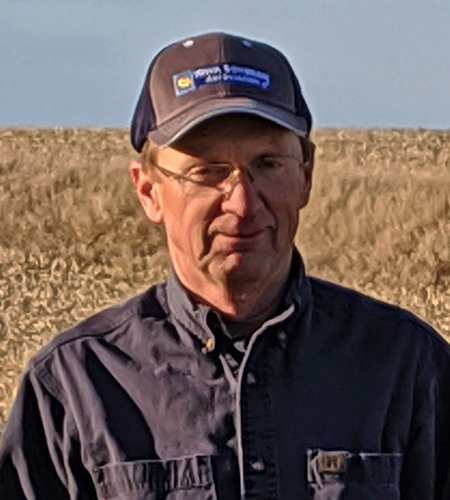Nutrient management is essential. Economically, it’s critical to keep nutrients in the fields and it’s also environmentally important.

Doug Carter
Pheasant Avenue Farms
Audubon County

Farming Operation
- 4th-generation family corn, soybean and hog farmer in Audubon County in west central Iowa
- Enrolled in Soil Health Partnership
- President of Audubon County Corn and Soybean Association
- Member of Iowa Soybean Association’s District Advisory Council
4R Plus Practices Used
- No-till on all acres; minimally invasive vertical-till utilized to inject hog manure
- Utilizes manure from hog finisher to enhance crop fertility
- Cover crops on one-third of acres
- Miles of terraces, waterways and buffer strips
- Grassed headlands on steepest land
- Grid soil sampling determines application rate of nutrients
Results Seen
- No. 1 goal of eliminating erosion has been achieved
- No-till improves soil structure to support equipment
- Adding cover crops improves organic matter and sequesters nutrients
- Attention to nutrient management saves on input costs
Plans for the Future
- Become comfortable planting into green cover crops
- Experiment with mixes of cover crops and application to improve weed suppression
- Continue to attend field days and research practices that enhance soil health
Click here to ask Doug a question about his farming operation.
Harvest 2020: Sticking with 4R Plus Practices Long-term
Improving soils is a long-term commitment according to Audubon County farmer Doug Carter. He missed the very worst of the derecho, but was in the bull’s eye of severe drought for much of the growing season. Both ultimately impacted his yields, but he believes 4R Plus practices helped limit the yield losses from these extreme weather events.
Carter is thankful the crops started out with decent soil moisture, which promoted root development, helping the crops withstand the drought conditions as the season progressed.
Click here for the full story.
Summer 2020: Cover Crop Growth Gets a Boost
The weather this spring threw Audubon County farmer Doug Carter a curve: it cooperated. He could have started planting corn and soybeans sooner than he did, but he decided to take advantage of a favorable weather forecast to get more growth on the cover crops.
His plan paid off. He still wrapped up planting the first week of May, which is much sooner than in recent years. “I waited, planted a little later than I could have, because I wanted to get more growth on the cover crop,” Carter said. “We got the growth and it worked well for weed control.”
Click here for the full story.
Spring 2020: Benefits of No-Till Enhanced by Cover Crops
Twenty years ago when Audubon County farmer Doug Carter realized he needed to change tillage systems, the rate of adoption for no-till was fairly slow. He recalls “a lot of unknowns” and a steep learning curve, but he was determined to make it work to stop erosion on his sloping land.
“There have been a lot of advancements made to no-till and planter equipment since I switched tillage systems,” Carter recalled. “Looking back I know the change had to be made to stop erosion.”
Through the years, Carter says no-till has resulted in other soil health improvements.
Click here for the full story.
